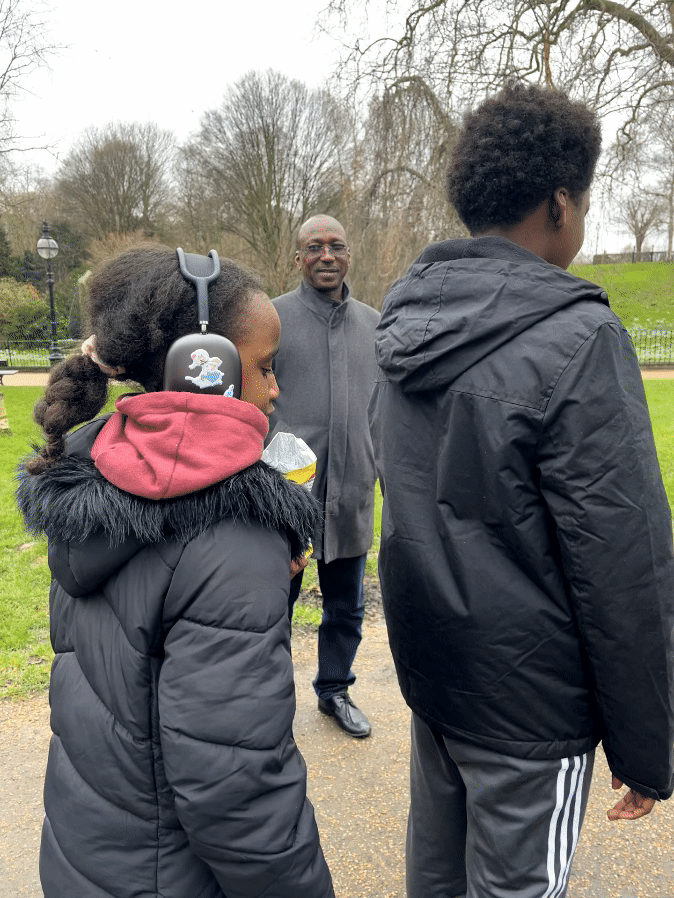Get in touch with me at ananyamanishdesigns@gmail.com
Co-presence
In collaboration with BitterSuite
Design Brief
Design a way to spread feelings.
Design Phase 1
Using qualitative user research methods to build foundational concepts.
Designers
Lyu Min, Rania, Jaitong Zhang, Fateema Nadeem, Ananya Manish
Research Methodologies
Bodymapping, Directed Storytelling, Bodystorming, AEIOU
Key words
Sensory Experience, Emotional Contagion, Design for Togetherness, Participatory Design Research, Sampling Methods
Designing a Way to Spread Feelings
The project initiated by the artists at Bittersuite challenged us to conceptualise a method to 'spread feelings.'

Bittersuite is an organisation that has been designing sensory experiences to re-imagine and deepen the way people listen to music since the last 10 years. This task, inspired by their unique approach to engaging the human sensory system by pairing music with other senses like smell and touch, pushed us to think about empathy and connection in new ways.

We began our exploration by attending a Bittersuite performance, which served as a vivid demonstration of how emotions can circulate among performers and audiences alike, setting a foundational understanding for our project. I was also intrigued by how they use music as an anchor and our collective knowledge of the sensory world to enable the spread of feelings.

Goals to Define Research Methadologies
Informed by Bittersuite's creative process, our objective was to craft an immersive, sense-led experience that encourages emotional contagion.

This goal led us to focus on three key areas for research:
-
Exploring the connection between the physical body and emotions to understand how feelings manifest physically.
-
Exploring emotional contagion through tactile experiences
-
Exploring environments that foster togetherness and facilitate emotional contagion.
Connect between Physical Body and Emotions
"Where do we hold feelings in our body?"
"How do we use our body to express feelings?"

For our research we wanted to explore how people hold and express feelings throughout their body. We decided to use participatory design research methods like body mapping and directed storytelling to enable people to self-express more freely and more comfortably (Liamputtong, P. 2019).

Our research was set up at an accommodation in North London and
using voluntary response sampling we collected data from 6 individuals. Our sample group consisted of people from the age of 18 – 26.
We initiated by creating a life size drawing of the participant. Using directed storytelling we asked them to narrate stories of their breakup, childhood and happy memory. Further we motivated them to locate these feelings in their physical body and express it through the body map.
We coupled this method with directed storytelling to establish the participant's credibility and thus, legitimacy of the research data.


It was truly impressive how this artistic method offered an alternative form of communication to convey the depth and complexity of embodied experiences. It intrigued us how people’s identity and commonalities were represented through these life size drawings. It was easy for participants to express experiential states such as frustration, joy and pain which may be difficult to verbally articulate.

Synthesizing Design Insights - Bodymapping
Our next goal was to find themes between different pieces of data. We translated the research into two data sets, happy emotions and sad emotions as located in the body. The synthesis of our research findings led us to certain hypotheses:


-
Perception, identity and feelings of people are interconnected with their physical body
-
People use textures, colors, expressions and movements to communicate their emotions.
-
The heart is often highlighted as a powerful symbol of emotion.
We were aware that our research could include sampling bias and thus wanted to push our research more further out.
Exploring Emotional Contagion Through Tactile Experiences
"How can connection be built from non-verbal communication?"
"Can feelings associated with music spread through touch?"

Learning from the synthesis we now wanted to explore how people express and spread emotion with their body through tactile interactions. There are multiple theories (Cespedes-Guevara, J. and Dibben, N. 2022) that talk about music-induced emotions proposing emotional contagion as a response to music. Leveraging on that we designed a body storming research activity.
Body storming is an embodied ideation and research method for movement-based interaction design (Márquez Segura, E., Turmo Vidal, L. and Rostami, A. 2016). It was truly beneficial to use such an interactive playful activity to inform the early stages of the design process.

Recruiting participants for research without a compelling incentive can be challenging. From past experiences, we learned the importance of an appealing reward system. To address this, we devised a creative strategy by aligning our research with an upcoming event—Valentine’s Day.
We promoted the activity as an opportunity for couples to strengthen their connection, enhancing participation appeal with the promise of chocolates and flowers as a thank-you gesture.


We conducted the study in Hyde Park, Central London, targeting a diverse group aged 12 to 45 through purposive sampling, gathering data from 10 participants. The activity involved one person listening to music via headphones and then communicating the emotions or type of music they experienced to their partner through touch.
Gathering Insights: Bodystorming
-
Observing the non-verbal communication between individuals with a pre-existing relationship provided valuable insights. It raised questions about fostering similar empathetic connections among strangers.
-
The tempo of the music impacted emotional contagion. Music with a higher tempo was always easier to guess. Higher musical tempo resulted in a higher affective arousal.

-
Participants often described the music with terms such as 'peaceful,' 'upbeat,' 'happy,' and 'a song that would play in a boat,' indicating their emotional interpretation.
-
Despite the insights gained, participants' physical movements were somewhat restrained. This highlighted a need for enriching the overall experience.
Exploring Immersive Sense-Led Experiences
"What languages/elements in the external environment enable spread of feeling?"
In the final phase of our research, we examined how emotional contagion occurs in real-world settings. We chose to observe at a musical theatre performance ("Les Miserables") and an interactive exhibition (UVA Synchronicity), employing the AEIOU observational framework.
Musical Theatre Insights: AEIOU as a passive participant

-
The storytelling and context provided by the theatre piece played a crucial role in creating an emotional bond and facilitating the spread of feelings among the audience.
-
The use of lighting and movement while supporting the narrative, also enhanced the emotional transmission.
-
Simply sharing the experience with others in the theatre helped to spread emotions among the audience members.

Interactive Exhibition Insights: AEIOU as an active participant

-
The interplay of light, darkness, colors, and movement evoked feelings of excitement, drama, and suspense.
-
People under the lights become part of the exhibition. They were unconsciously synchronising their behaviour with the light movements.

-
The line between spectators and participants was blurred, offering a deeply immersive experience.


Concluding Thoughts
Our qualitative research across various domains— from the intimate connection between body and emotion to the communal experience of shared spaces—highlights the intricate dance of elements that contribute to the spread of feelings. As we continue to refine our approach, the insights gained lay a solid foundation for future steps in the design process.
References
Liamputtong, P. (2019). Handbook of research methods in health social sciences. Singapore: Springer.
Boydell, K. (2020). Applying Body Mapping in Research An Arts-Based Method. Milton: Taylor & Francis Group.
Shusterman, R. (1999). Somaesthetics: A Disciplinary Proposal. The Journal of Aesthetics and Art Criticism, 57(3), p.299. doi:https://doi.org/10.2307/432196.
Márquez Segura, E., Turmo Vidal, L. and Rostami, A. (2016). Bodystorming for movement-based interaction design. Human Technology, 12(2), pp.193–251. doi:https://doi.org/10.17011/ht/urn.201611174655.
Cespedes-Guevara, J. and Dibben, N. (2022). The Role of Embodied Simulation and Visual Imagery in Emotional Contagion with Music. Music & Science, 5, p.205920432210938. doi:https://doi.org/10.1177/20592043221093836.
Herrando, C. and Constantinides, E. (2021). Emotional Contagion: A Brief Overview and Future Directions. Frontiers in Psychology, [online] 12. doi:https://doi.org/10.3389/fpsyg.2021.712606.